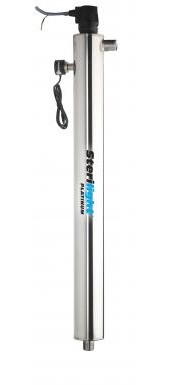NSF/ANSI Standard 55 For Ultraviolet Systems: A Double Standard
Performance standards for point of use and point of entry ultraviolet purifiers are certified under two distinct classes by ANSI/NSF under standard 55. Here’s how the NSF Website describes it:
NSF/ANSI Standard 55: Ultraviolet Microbiological Water Treatment Systems
Overview: This standard establishes requirements for point-of-use (POU) and point-of-entry (POE) non-public water supply (non-PWS) ultraviolet systems and includes two optional classifications. Class A systems (40,000 uwsec/cm2) are designed to disinfect and/or remove microorganisms from contaminated water, including bacteria and viruses, to a safe level. Class B systems (16,000 uw-sec/cm2) are designed for supplemental bactericidal treatment of public drinking water or other drinking water, which has been deemed acceptable by a local health agency.
UV dosage is typically described in units called “Joules,” and it is most frequently expressed in terms of “milliJoules per second per square centimeter,” or
mJ/cm². Microwatts per second per square centimeter, expressed as µWs/cm2 and mJ/cm2 represent the same dosage and are used interchangeably. The NSF description above is expressed in microwatts. The UV dosage is an expression of the UV strength with consideration of how fast the water flows past the lamp. The higher the number, the higher the dosage. The UV dosage increases as the flow rate of the water being treated decreases, so a UV unit that puts out a dosage of 16 mJ/cm² while treating water at a flow rate of eleven gallons per minute (gpm) will be rated as 40 mJ/cm² if the flow rate is decreased to 4.5 gpm.In addition to the dosage requirement, NSF certification for Class A also involves requirements for monitoring devices, alarms, and safety shutoffs that assure that the equipment is working properly and that the user will not inadvertently use water that has not been treated. The devices specified are mainly to protect against equipment failure and power outages.
Should you buy only a NSF certified UV unit for your home?
Not necessarily. The cost is considerably higher and, speaking frankly, some of the sophisticated electronic features furnished with class A systems are more a bother than a benefit. A safety device, for example, that shuts off the water to your home when the UV performance dips from being ten times as strong as necessary to a mere nine times as strong as necessary might not make you happy.
Almost all UV units on the market qualify for class B certification, although most manufacturers do not certify to Class B because of the expense. (NSF certification is very expensive, and it is an ongoing expense; the manufacturer must pass this expense on to the customer.)
Class A certification is in many cases necessary. With public drinking water facilities (in churches, restaurants, office buildings, for example) use of Class A systems is often required by state regulations, and a few states require Class A for private homes. In most private homes across North America, however, non-certified UV systems are much more common and are typically sufficient.
Consider:
Ratings for dosage are figured at the end of the lamp’s recommended life (one year in most cases) and at the specified rate of flow. If you have a UV unit that is rated for 15 gpm, however, almost all of your residential water use will be done at a fraction of that. If your unit is rated for 16 mJ at 15 gpm, your water will be treated at much higher than the 16 mJ rating except for the rare occasions when, if ever, you actually run water at 15 gpm. And at 15 gpm, on the last day of the lamp’s specified lifespan, the dosage is still double what it needs to be to take care of E. coli, giardia, and cryptosporidium, the items that are of concern for most residential well owners.
In other words, with UV there is considerable overkill and a great margin for error built in.





